Hawks are majestic birds of prey, known for their keen eyesight and impressive hunting skills. They are carnivorous birds that hunt and eat a variety of animals, including rodents, fish, insects, reptiles, and other birds.
One common question that many people ask is, “Do hawks eat mice?”
In this article, we will explore the eating habits of hawks and focus specifically on whether they eat mice. Understanding the diet of these birds is important for several reasons.
First, it helps us appreciate their role in the ecosystem as predators that help control rodent populations. Second, it sheds light on how hawks adapt to different types of environments and prey availability.
Table of Contents
- 1 Explanation of the Topic
- 2 Importance of Understanding the Eating Habits of Hawks
- 3 Overview
- 4 What are hawks?
- 5 What do Hawks Eat?
- 6 Do hawks eat mice?
- 7 Other Food Sources for Hawks
- 8 How Hawks Adapt to Different Environments
- 9 The role of Hawks in the ecosystem
- 10 The Impact of Humans on Hawk Populations
- 11 Conclusion
- 12 FAQs: Do Hawks Eat Mice?
- 12.1 How do hawks locate mice?
- 12.2 Are mice the primary food source for hawks?
- 12.3 Do hawks hunt mice during the day or at night?
- 12.4 How do hawks capture and kill mice?
- 12.5 Can hawks eat mice that are larger than them?
- 12.6 How often do hawks eat mice?
- 12.7 Do hawks eat only live mice, or will they scavenge on dead ones?
- 12.8 Do hawks have any natural predators that prey on them?
- 12.9 Are there any hawk species that specifically specialize in hunting mice?
- 13 Author
Explanation of the Topic
Birds of prey like hawks have been around for millions of years and play an essential role in maintaining a balanced ecosystem.
These birds are known for their sharp talons and hooked beaks, which enable them to easily catch and feed on smaller animals like mice.
Understanding what these powerful hunters eat can give us important insights into how ecosystems function, as well as help us appreciate the diversity of life surrounding us.
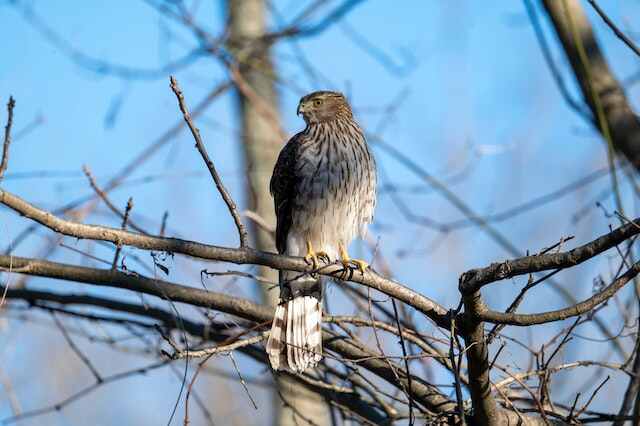
Importance of Understanding the Eating Habits of Hawks
Hawks are apex predators in many environments, where they hunt various kinds of prey depending on habitat type and availability. As such, they play an important ecological role by helping to control populations of small mammals like mice.
Mice population growth can become problematic if unchecked, leading to environmental degradation or disease spread, affecting both human health directly or indirectly through their pets.
By understanding what hawks typically feed on, we can better understand how food webs work in nature which ultimately informs conservation efforts aimed at preserving bird populations.
Overview
In this article we’ll first provide a brief definition for hawks followed by discussing the types of hawks and their habitats.
We’ll then explore what hawks eat in general, before focusing specifically on if they eat mice and how they do it.
Furthermore, we will delve into the nutritional value of mouse prey for hawks.
We will also discuss other food sources for hawks, their role in the ecosystem as well as human impact on hawk populations, including conservation efforts aimed at maintaining healthy bird populations.
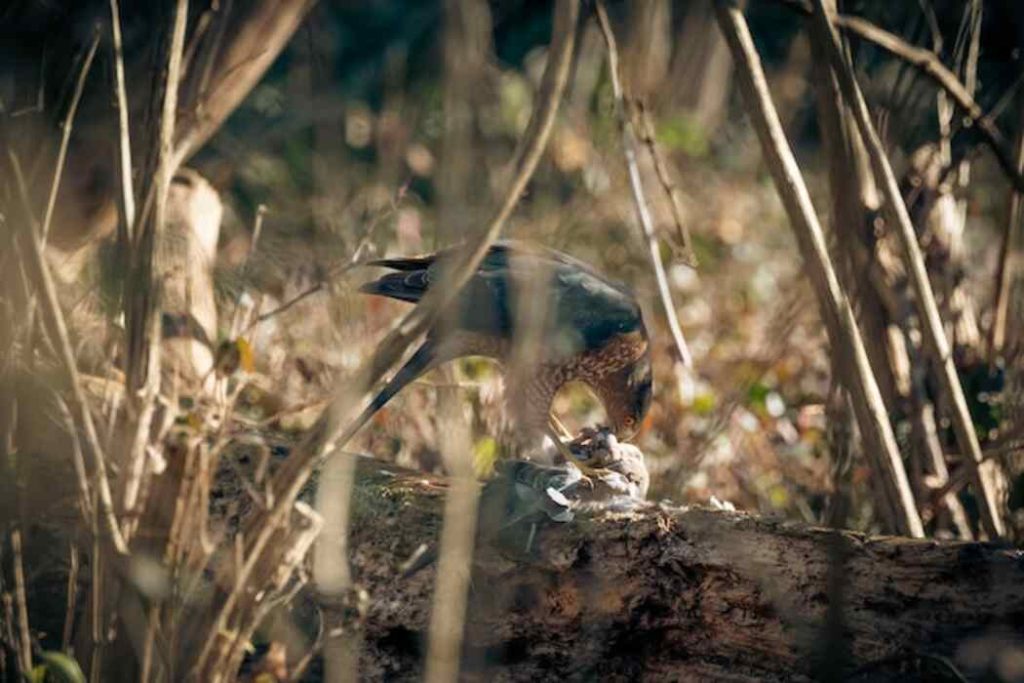
What are hawks?
Hawks are birds of prey that belong to the family Accipitridae, which includes eagles, kites, and harriers.
These predatory birds have keen eyesight, sharp talons, and powerful wings that enable them to hunt and capture their prey with great efficiency.
Hawks range in size from small species like the sharp-shinned hawk to larger species like the red-tailed hawk.
Definition and characteristics of hawks
Hawks are characterized by their hooked beaks, sharp talons and keen eyesight. They are carnivorous birds that feed on a variety of prey items including mammals, reptiles, birds and insects.
The morphology of hawks varies greatly depending on the species, but they all share similar traits such as powerful wings for sustained flight and broad tails for maneuverability.
Different types of hawks and their habitats
There are over 200 species of hawks worldwide with varying habitats ranging from forests to open grasslands.
Some common North American hawks include the Cooper’s hawk, red-tailed hawk, sharp-shinned hawk, northern goshawk among others.
Each type has unique characteristics, such as hunting behavior or preferred habitat, which is influenced by their diet requirements.
The Cooper’s hawk is found in deciduous forests across North America, while the Red-Tailed Hawk prefers open fields where they can easily spot prey from above.
Sharp-shinned Hawks are smaller than other members of the Accipiter genus but make up for it with agility, making them successful hunters in dense woodlands where they can catch small songbirds mid-flight.
Physical features that make them effective hunters
The physical attributes of hawks contribute significantly to their success as predators. Their long legs give them a stable platform when perched or striking at prey, while their large wingspans allow them to soar at high altitudes for extended periods.
Hawks also have an exceptional sense of vision that enables them to spot movement from great distances making hunting easier.
Additionally, their hooked beaks and razor-sharp talons allow them to grab and kill prey effectively.
Hawks also possess physical adaptations such as nictitating membranes, which are clear eyelids that protect and moisten their eyes during flight.
This enables the birds to keep their eyes open even while diving at high speeds or challenging predators.
Hawks are predatory birds that belong to the Accipitridae family, known for their sharp talons, hooked beaks and keen eyesight.
Over 200 species of hawks exist worldwide with varying habitats including forests, grasslands among others.
Their physical adaptations such as long legs, large wingspans and nictitating membranes make them efficient hunters on land or in flight.

What do Hawks Eat?
The General Diet of Hawks
Hawks are carnivorous birds and primarily feed on other animals. Their diet can vary based on the species of hawk and their habitat. Generally, hawks eat small to medium-sized prey, including rodents, birds, fish, and insects.
Some larger species of hawks can prey on animals such as rabbits or snakes. The general diet of a hawk is dependent on its size and location.
Prey Selection Based on Size and Availability
Hawks are selective when it comes to choosing their prey. They will typically choose animals that are smaller than themselves, as larger prey may be too challenging to catch or overpower.
The availability of food also plays a role in the selection process, as they will target whatever is abundant in their environment at the time.
In areas where there are abundant mice populations, for example, hawks will hunt mice frequently as they provide an ideal source of food that is readily available.
In areas with low mouse populations, hawks may shift their focus to other types of prey.
How They Hunt Their Prey
Hawks have several hunting techniques that they use to catch their prey successfully. Some species like red-tailed hawks prefer to perch in a high vantage point from where they can spot potential targets on the ground below them.
Other species like Cooper’s hawk hunt by flying low through dense vegetation or forests, where they can ambush small birds or rodents.
They also use stealth-like movements when flying close to the ground so that they do not scare off their prey before making a kill.
When hunting larger animals like rabbits or squirrels, some species like northern goshawk chase them through trees until they tire out before making a kill.
The Importance of Understanding What Hawks Eat
Understanding what hawks eat is essential for several reasons. It can help to identify the species of hawk in a particular region by looking at what they eat.
Additionally, understanding a hawk’s diet can also help to determine its impact on the ecosystem and manage populations in areas where they may be over-preying on certain species.
Knowing what hawks eat also helps to prevent human-wildlife conflicts as some hawks, like red-tailed hawks, may prey on domestic animals like chickens or small pets.
By understanding their diet and feeding habits, we can take measures to protect our pets and prevent such conflicts from happening in the first place.
Do hawks eat mice?
Hawks are birds of prey that are known for their excellent hunting abilities. They have a sharp beak, strong talons, and incredible eyesight that allows them to hunt and kill their prey with great precision.
Mice are one of the most common prey items for hawks, as they are small and abundant in many environments.
Explanation of why mice are a common prey for hawks
Mice make up a significant portion of a hawk’s diet, especially during the winter months when other food sources may be scarce.
One reason why mice are such a popular choice for hawks is because they are readily available in most environments. They can be found in fields, forests, and even urban areas.
Additionally, mice are small and relatively easy to catch, making them an attractive target for birds of prey like hawks.
Another reason why mice make such good prey for hawks is because they reproduce quickly and have high populations.
This means that there is always an abundance of mice available for the hawk to hunt. Mice also tend to be active during the day which makes them more vulnerable to attack.
How they catch and kill mice
Hawks use several different techniques to catch mice, depending on their environment and the type of hawk.
Some species like the Red-tailed Hawk prefer to sit on high perches, scanning the ground below until they spot their prey.
Once they see a mouse scurrying along, they will swoop down at lightning speed, using their sharp talons to grab it out of midair.
Other species like the Cooper’s Hawk use stealthier tactics. They will fly low over fields or forests looking for movement among the grass or bushes before suddenly diving down onto their unsuspecting victim.
Once caught, hawks will either kill their prey immediately by crushing its skull with its powerful beak or hold it down with their talons and suffocate it.
Hawks are incredibly efficient hunters and rarely miss their target.
Nutritional value for the hawk
Mice are an excellent source of nutrition for hawks. They are small enough to be eaten whole, providing the hawk with all the necessary nutrients it needs to survive.
Mice are high in protein and fat, which is essential for hawks, as they require a lot of energy for hunting and flying.
Hawks will often eat several mice a day, depending on their size and nutritional needs. They will store excess food in caches to eat later if they cannot find prey again soon.
Overall, mice are a vital part of a hawk’s diet, providing them with the necessary nutrients to thrive in their environment.
Understanding the relationship between hawks and mice can help us better appreciate these incredible birds of prey and the important role they play in our ecosystem.
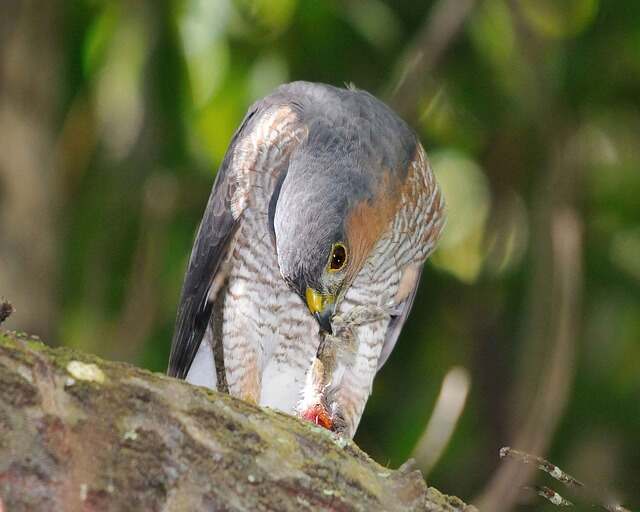
Other Food Sources for Hawks
Fish
Although hawks are often associated with capturing mice and other small mammals, many hawks also feed on aquatic prey, including fish.
Fish can be an important food source for certain hawk species, such as the osprey, which is commonly known as a fish eagle due to its preference for fish.
Other hawks that feed on fish include red-tailed hawks and bald eagles. Hawks that hunt for fish have evolved to become exceptional divers and swimmers.
Ospreys, for example, have specially adapted talons with reversible outer toes and spiny scales on their soles which enable them to grasp slippery fish in mid-flight or underwater.
They are also able to close their nostrils when diving into water to avoid inhaling water while they catch their prey.
Insects
Insects make up a significant portion of the diet of many hawk species. Hawks will feed on various insects such as grasshoppers, crickets, bees and dragonflies among others.
These small creatures provide rich nutrients, including proteins that help maintain strong muscles used in flight.
To capture insects, hawks use a variety of hunting techniques depending on the species of hawk and type of insect they are after.
For example: some will fly low over fields to flush out grasshoppers, while others may perch high up in trees or atop large rocks, waiting patiently until they spot an opportunity before making their swift dive towards the ground.
Reptiles
Hawks have been known to feed on reptiles such as lizards and snakes but this is not common across all species of hawk.
The Harris’s hawk specifically has been observed feeding frequently on lizards due to its unique ability as a bird-of-prey that hunts in groups, providing greater chances in capturing larger prey such as snakes.
When hunting for reptiles, hawks have developed an exceptional adaptation to avoid getting bitten by their venomous prey.
They will capture the reptile with their talons and then quickly shake it until it becomes disoriented and unable to bite.
Birds
Other birds are a common food source for some hawk species. Hawks that feed on other birds catch them in flight or while they are perched on a branch.
Some of the bird species that hawks are known to feed on include pigeons, parrots, doves and smaller raptors such as kestrels and falcons.
To capture birds, hawks have developed techniques that enable them to overcome the bird’s agility in the air or stealth in hiding among trees.
For instance, some hawk species such as Cooper’s hawk can fly through dense forests at high speeds with ease while keeping an eye out for any potential prey items.

How Hawks Adapt to Different Environments
Hawks have adapted over time to live in various regions worldwide. Each species has unique adaptations specific to its environment which enable it to survive.
Different types of hawks reside and thrive in diverse habitats like arid deserts, lush forests, wetlands or open grasslands depending on their food requirements.
A good example is the Swainson’s hawk, which lives mainly in prairies where there are abundant ground squirrels, which make up most of its diet.
Some adaptations used by hawks include keen vision that allows them to spot prey from great distances; strong wings which can carry them upward easily; and sharp talons that allow them to grab onto prey firmly without slipping away.
Understanding what hawks eat is essential when studying these magnificent birds.
While mice are one of their primary food sources, they also feed on a variety of other animals including fish, insects, reptiles and birds.
Adaptation is also crucial for hawks to survive in different environments. Each species has unique adaptations specific to its environment which enable it to thrive.
The role of Hawks in the ecosystem
Hawks are a vital part of the ecosystem, as they play a crucial role in maintaining the balance of nature. They are apex predators, meaning that they are at the top of the food chain and have no natural predators.
This means that hawks control populations of prey species, which has a positive impact on other organisms in their environment.
Benefits to controlling rodent populations
One of the most important benefits that hawks provide is controlling rodent populations. Many species of hawks feed on rodents such as mice, rats and voles.
These animals can cause significant damage to crops and other vegetation if left unchecked.
By preying on rodents, hawks help to keep their populations in check and prevent them from becoming too numerous.
In addition to reducing damage caused by rodent infestations, hawks also serve as a natural form of pest control for humans.
This has economic benefits for farmers who rely on crops for their livelihoods.
Rather than having to use harmful chemicals or employ expensive pest control measures, farmers can rely on hawks to keep rodent populations under control.
Interaction with other predators
Hawks also interact with other predators in their ecosystems. For example, some species may compete with owls for prey or even prey upon them themselves.
Additionally, larger bird species such as eagles may pose a threat to smaller hawk species.
Despite these interactions, hawks generally coexist peacefully with other predators in their environment.
In fact, they may even benefit from these interactions by scavenging leftover prey that other predators have killed.
Overall, it is clear that hawks play an essential role in many ecosystems around the world.
By controlling rodent populations and interacting with other predators, these majestic birds help maintain ecological balance and ensure healthy environments for all organisms involved.
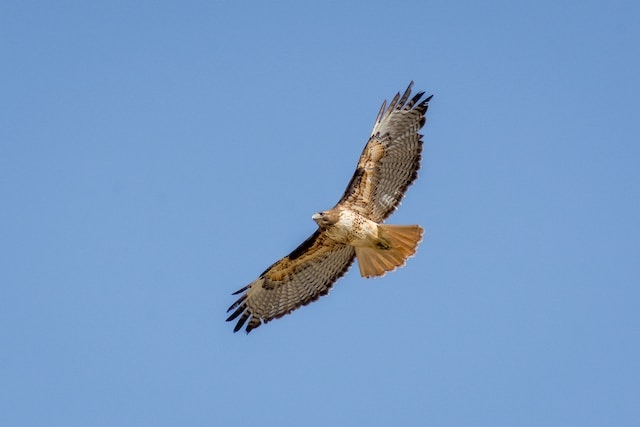
The Impact of Humans on Hawk Populations
Humans have had a significant impact on hawk populations. One of the primary threats to hawks is habitat loss due to deforestation, urbanization, and agriculture.
As natural habitats disappear, hawks must adapt to new surroundings or face extinction.
For example, the fragmentation of forests leads to the isolation of hawk populations and reduces their genetic diversity, making them more vulnerable to disease and changes in environmental conditions.
Another major threat comes from human activity such as hunting, trapping, and poisoning.
Illegal poaching for feathers or falconry also contributes to dwindling hawk populations. Pesticides used by farmers can also poison hawks that feed on contaminated prey.
Hawk Conservation Efforts
To protect hawks and promote their survival in the wild, various conservation efforts have been initiated over the years by government organizations and non-profit groups.
One such initiative includes habitat restoration programs aimed at creating new habitats where the hawks can thrive.
These programs provide breeding grounds for hawks while protecting their natural environment from human interference.
Other efforts include captive breeding programs that aim to increase hawk numbers by breeding them in captivity before releasing them back into the wild.
The release of these birds is carefully monitored with tracking devices so experts can study their behaviors after release.
Threats to Hawk Survival
The biggest threat facing hawk survival today is climate change. Climate change alters natural environments (such as temperature) which causes food sources for hawks to diminish or move elsewhere.
This forces hawks into unfamiliar environments which they may not be equipped for leading to a higher likelihood of death or injury from lack of nourishment Predator control is another issue that threatens hawk populations through poisoning campaigns against other animals .
But hawks can inadvertently ingest the same poison, which can lead to their death. In case of conflict with humans, hawks are often viewed as pests and needlessly destroyed.
The Road Ahead
While conservation efforts have helped in protecting hawk populations, their survival remains tenuous.
Further research is needed to understand the full extent of human impact on hawk populations and what steps society should take to protect these magnificent birds.
The key takeaway is that we must be mindful of our actions in order to coexist with these predators who play a vital role in our ecosystem.
Conclusion
Summary of Key Points:
Throughout this article, we have explored the eating habits of hawks and their significance in the ecosystem.
We have learned about hawks’ physical characteristics that make them effective hunters and their general diet, which includes rodents such as mice.
We have also looked at the benefits they provide for controlling rodent populations and their role in interacting with other predators. Importance of Understanding Hawk’s Eating Habits:
Understanding hawk’s eating habits is vital for several reasons. First, it helps us appreciate their role in nature and how they help maintain a balance in the ecosystem.
Second, it enables us to identify which species are threatened by changes in habitat or human activities that disrupt their food sources.
Third, knowing what hawks eat can aid us in managing pests by understanding how predators interact with prey populations.
Moreover, studying hawk’s feeding behavior allows us to gain insight into predator-prey relationships and the ecological processes that regulate these interactions.
It provides a unique opportunity to examine niche dynamics, population ecology, and other related topics.
Future Research Directions:
Further research could focus on answering questions about hawks’ feeding behavior that remain unanswered.
For instance: What factors influence prey selection? How do different species adapt to different environments?
How does competition between predators affect prey availability?
In addition to exploring these topics further using traditional methods such as field observation and experimentation, advances in technology offer new avenues for studying predator-prey interactions using remote sensing techniques like drones or satellite imagery.
A Vision for Hawk Conservation:
Hawk conservation efforts should aim to protect habitats essential for breeding, nesting sites, roosting areas, as well as preserve food resources like rodents and other small mammals critical to their survival.
A coordinated effort between conservationists, policymakers, and the public can help ensure that future generations of hawks thrive in their natural habitats.
Understanding a hawk’s eating habits is crucial to maintaining a healthy ecosystem, managing pest populations efficiently, and gaining insights into predator-prey dynamics.
As we continue to learn more about these magnificent birds of prey, we also become more aware of our impact on their survival and can take steps towards protecting them for future generations.
FAQs: Do Hawks Eat Mice?
How do hawks locate mice?
Hawks have excellent eyesight and rely on their keen vision to locate mice on the ground. They scan the area from perches or while flying, looking for movement or any signs of small mammals. Once they spot a potential prey, they use their sharp vision to track its movements before swooping down to catch it.
Are mice the primary food source for hawks?
While mice are a common food source for hawks, they are not the only prey they feed on. Hawks have a diverse diet that also includes other small mammals, birds, reptiles, and even insects. Their food preferences may vary depending on the hawk species and their habitat.
Do hawks hunt mice during the day or at night?
Most hawks are diurnal hunters, meaning they primarily hunt during the day. They have adapted to spot and catch mice when they are active during daylight hours. However, there are a few owl species that are known to hunt mice at night, taking advantage of their nocturnal behavior.
How do hawks capture and kill mice?
Hawks use a hunting technique called “stooping” to capture mice. They dive swiftly from the air, reaching high speeds, and strike their prey with their sharp talons. The impact of the stoop, combined with the hawks’ powerful grip, is usually enough to immobilize or kill the mouse instantly.
Can hawks eat mice that are larger than them?
Hawks generally target prey that they can handle and lift off the ground. While they can tackle relatively large mice, they typically prefer smaller-sized mice that are easier to catch and carry. If a mouse is exceptionally large or heavy, a hawk may struggle to lift it and may seek smaller prey instead.
How often do hawks eat mice?
The frequency of hawks feeding on mice varies depending on factors such as their size, metabolism, and availability of prey. Generally, hawks need to consume food regularly, often on a daily basis. They may consume multiple mice in a single feeding or feed on smaller portions throughout the day.
Do hawks eat only live mice, or will they scavenge on dead ones?
Hawks are primarily predators and prefer to catch live prey. However, they are opportunistic feeders and may scavenge on dead animals, including mice, if the opportunity arises. If a hawk comes across a carcass, it may feed on it, but live prey remains their primary source of food.
Do hawks have any natural predators that prey on them?
Hawks are skilled predators and are generally not preyed upon by other animals. However, there are a few predators that pose a threat to hawks, especially their eggs and young. Some examples include larger birds of prey, such as owls and eagles, as well as land predators like foxes, raccoons, and snakes.
Are there any hawk species that specifically specialize in hunting mice?
While many hawk species include mice in their diet, some species are known to specialize in hunting small mammals like mice. The Northern Harrier (Circus hudsonius), for instance, is known for its low-flight hunting technique and has a particular affinity for mice and voles. These hawks are highly adapted to catching and feeding on small rodents.

